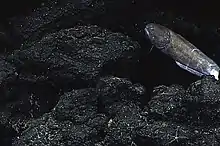Needletooth cusk
The needletooth cusk (Epetriodus freddyi) is a species of cusk-eel found in the Indian and the western Pacific Ocean where it occurs at depths of 1,000 to 1,750 metres (3,280 to 5,740 ft). This species grows to a length of 21.5 centimetres (8.5 in) SL. It is the only known species of its genus[1] The generic name is a compound of the Greek epetrion meaning "needle" and odous meaning "tooth", while the specific name honours the English ichthyologist Norman Bertram “Freddy” Marshall (1915-1996) who worked on deep sea fishes as the British Museum (Natural History).[2]
| Needletooth cusk | |
|---|---|
 | |
| Scientific classification | |
| Domain: | Eukaryota |
| Kingdom: | Animalia |
| Phylum: | Chordata |
| Class: | Actinopterygii |
| Order: | Ophidiiformes |
| Family: | Ophidiidae |
| Subfamily: | Neobythitinae |
| Genus: | Epetriodus |
| Species: | E. freddyi |
| Binomial name | |
| Epetriodus freddyi Cohen & J. G. Nielsen, 1978 | |
References
- Froese, Rainer; Pauly, Daniel (eds.) (2012). "Epetriodus freddyi" in FishBase. June 2012 version.
- Christopher Scharpf & Kenneth J. Lazara (21 March 2018). "Order Ophidiiformes: Families Carapidae and Ophidiidae". The ETYFish Project Fish Name Etymology Database. Christopher Scharpf and Kenneth J. Lazara. Retrieved 12 July 2018.
This article is issued from Wikipedia. The text is licensed under Creative Commons - Attribution - Sharealike. Additional terms may apply for the media files.